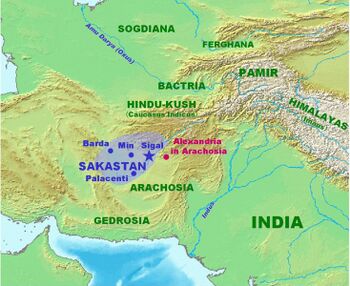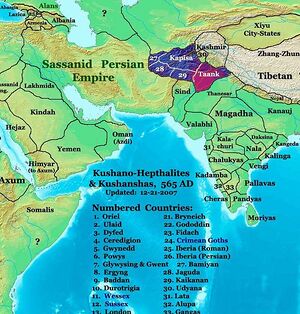Singroha

Singroha (सिंगरोहा)Sangroha (संगरोहा) Sigroha (सिगरोहा) Sigga (सिग्गा) Singhrowa (सिंघड़ोवा)Sigar (सीगड़ सुगड) Singar "Sirota (सिंगरोता सिरोठा) [1] Singad Sangad (सिंगड सुगड सांगड)) Singroda (सिंगरोदा)[2] (Singroha, Sangroya, Singroya, Sigga, Sirotha, Singroda Sigar Jat gotra is found in Haryana, Uttar Pradesh, Madhya Pradesh and Rajasthan. Sigga, Sirotha and Singroda Sigar 'are same as Singroha.
Jat clans mentioned by Megasthenes
Megasthenes also described India's caste system and a number of clans out of these some have been identified with Jat clans by the Jat historians. Megasthenes has mentioned a large number of Jat clans. It seems that the Greeks added 'i' to names which had an 'i' ending. Identified probable Jat clans have been provided with active link within brackets. (See Jat clans mentioned by Megasthenes)
| Jat clans as described by Megasthenes | ||||||||||||
| Location | Jat clans | Information | ||||||||||
|---|---|---|---|---|---|---|---|---|---|---|---|---|
| 10. Below the deserts are | The Dari (Dar, Dara, Darwal), the Surae (Sur, Sauran, Soora, Surve), the Maltecorae (Maltiya), Singhae (Sangha, Singa, Singad, Singroha Singhal, Singhar, Singwa), Marohae (Maru, Maurya, Marohi), Rarungae (Rangi,Rara), Moruni (Mor) | These inhabit the hills which in an unbroken chain run parallel to the shores of the ocean. They are free and have no kings, and occupy the mountain heights, whereon they have built many cities | ||||||||||
Origin
They have originated from Shigru of Rigvedic tribe.[3]
- According to Hukum Singh Panwar they are Sringala of the Harivamsa Purana (65, 15-20), the Sringin (शृङ्गिन) of Mahabharata (II, 47, 26) and (I.36.21,24)[4]. [5]
- Hukum Singh Panwar (Pauria) writes:[6] The Jat tribes[7] Sigroa or Sigroha bear unmistakable identity With the so-called Rigvedic non-Aryan people named Sigru of the east. other Jat tribes[8] closely resemble several other Rigedic Aryan tribes. Among such Jat tribes are Singala or Singla or Singar or Sangar.[9]
- According to Dr Mahendra Singh Arya and others, this gotra originated from place named Sigal. This place is the royal residence of the Sakas, in Sistan (सीस्तान) in Iran/Afghanistan. [10]
Jat Gotras Namesake
- Singroha (सिंगरोहा) (Jat clan) → Singorgarh (सिंगौरगढ़). Singorgarh (सिंगौरगढ़) is a fort located in Damoh district of Madhya Pradesh, India. Singorgarh fort is about 45 km from Jabalpur city, on the way to Damoh town. There was civilization here in older times. King Vain Bason/ Vain Basore had built a big and strong fort and the Gawe kings ruled over here for a long time. There is also a lake here, which is full of lotus flowers. This is an ideal picnic spot.[11]
Mention by Pliny
Pliny[12] mentions Arabia.....Next to these are the Chaculatæ; then the town of Sibi, by the Greeks called Apate42; the Arsi, the Codani, the Vadei, who dwell in a large town, the Barasasæi, the Lechieni, and the island of Sygaros43, into the interior of which no dogs are admitted, and so being exposed on the sea shore, they wander about there and are left to die.
42 A name which looks very much like "fraud," or "cheating," as Hardouin observes, from the Greek ἀπάτη.
43 Off the Promontory of Ras-el-Had.
In Mahavansa
Siggava was a sage, son of a minister, mentioned in Mahavansa/Chapter 5.
Mahavansa/Chapter 5 mentions ....
Now the mighty and believing king and thera Moggaliputta had already in former times been seen by the holy ones.
At the time of the Second Council, the theras, looking into the future, saw the downfall of the faith in the time of that king. Looking around in the whole world for one who should be able to stay that downfall, they saw the Brahmä Tissa who had not long to live (in the Brahma heaven). To him they went and prayed him, the mighty in wisdom, to bring this downfall to nought by being reborn himself among men. And he granted their prayer, desiring that the doctrine should shine forth in brightness. But to the youthful Siggava and Candavajji the sages spoke thus: 'When a hundred and eighteen years are passed the downfall of the religion will begin. We shall not live to see that (time). You, bhikkhus, have had no part in this matter' therefore you merit punishment, and your punishment shall be this: that the doctrine may shine forth in brightness, the Brahma Tissa, mighty in wisdom, will be reborn in the house of the brahman Moggali. As time passes on one of you shall receive the boy into the order, another shall carefully instruct him in the word of the Sambuddha.
There was a thera Dasaka-disciple of the thera Upali. Sonaka was his (Dasaka's) disciple, and both those theras were disciples of Sonaka.
In former times there lived in Vesali a learned brahman named Dasaka. As the eldest of three hundred disciples he dwelt with his teacher, and at the end of twelve years having come to the end of (studying) the vedas, he, going about with the (other) disciples, met the thera Upali, dwelling at the Valika-monastery, after he had established the sacred word (in council), and sitting down near him he questioned him concerning hard passages in the vedas, and the other expounded them to him. 'A doctrine is come after all the doctrines, O brahman, yet all doctrines end in the one doctrine; which is that one?'
Thus spoke the thera concerning the name (of the true doctrine), but the young brahman knew it not. He asked: 'What manta is this?' and when the answer was given: 'The manta of the Buddha,' he said: 'Impart it to me,' and the other answered: 'We impart it(only) unto one who wears our robe.'
And he (Dasaka) asked his teacher and also his father and mother on behalf of that manta. When he with three hundred young brahmans had received from the thera the pabbajjä the brahman in time received the upassada Then to a thousand (disciples) who had overcome the asavas, among whom was the thera Dasaka, did the thera Upali teach the whole tipitaka. Past reckoning is the number of the other Ariyas, and of those who yet stood outside (the religion), by whom the pitakas were learned from the thera.
In the land of the Kasi lived the son of a caravan-guide, named Sonaka. With his father and mother he had come trading, to Giribbaja. He went, youth as he was, fifteen years old, into the Veluvana (monastery); fifty-five young brahmans, his companions, came with him.
When he saw the thera Däsaka there with his disciples around him, faith came to him and he asked him for the pabbajja-ordination. (The thera) said: 'Ask thy teacher.' Afterwards, the young Sonaka, having fasted three meal-times and won his parents' leave to enter the order, came again, and then, when he had received from the thera Dasaka the pabbajja and the upasampada, together with those other youths, he learned the three pitakas. Amid the company of the thousand disciples of the thera, who had overcome the asavas, who were versed in the pitakas, the ascetic Sojiaka was the foremost.
In the city that bears the name of the patali flower there lived the wise Siggava, son of a minister. He, when eighteen years old and dwelling in three palaces fitted for the three seasons of the year, went, in company with his friend Candavajji, a minister's son, and surrounded by five hundred followers, to the Kukkutarama, and visited the thera Sonaka.
And when he perceived that (the thera) sat sunk in a trance with senses restrained' and did not answer his greeting, he asked the brotherhood about this matter. They said: 'Those who are deep in a trance give no reply.' (So he asked) 'How come they forth from (the trance)?' And the bhikkhus said:
'At a call from the master, or a call from the brotherhood, or. when the allotted time is ended, or at the approach of death they come forth (from the trance).'
As they saw, speaking thus, that these (youths) were destined for holiness, they caused the call from the brotherhood to be given; and (the thera) awoke from the trance and went to them. The youth asked: 'Wherefore didst thou not speak to me, venerable one?' The (thera) answered: 'We were enjoying that which is for us to enjoy.' The (young man) said: 'Let us also enjoy this.' He answered: 'Those only can we cause to enjoy it who are like unto us.'
Then, with their parents' leave, the young Siggava and Candavajji and their five hundred followers likewise received the pabbajja and (afterwards) the upasampada-ordination from the thera Sonaka. With him as their master the two eagerly studied the three pitakas and attained to the six supernormal powers.
Thereafter when Siggava knew that Tissa had been born into this world, the thera, from that time, frequented his house for seven years. And not for seven years did it befall him to hear the words 'Go further on' (said to him). But in the eighth year did he hear those words 'Go further on', in that house. As he went forth the brahman Moggali, who was even then coming in, saw him and asked him: 'Hast thou received aught in our house?' And he answered: 'Yes.' When (Moggali) went into his house he heard (what had befallen) and when the thera came to the house again, on the second day afterwards, he reproached him with the lie. And when he had heard the thera's words the brahman, full of faith, gave him continual alms of his own food, and little by little did all of his household become believers, and the brahman continually offered hospitality (to the thera), giving him a seat in his house.
So as time passed the young Tissa gradually came to the age of sixteen years and reached the further shore of the ocean of the three vedas. The thera, thinking that he might have speech with him in this way, made all the seats in his house to vanish, save the seat of the young brahman. Being come from the Brahma-world (this latter) loved cleanliness, and therefore were they used to keep his chair hung up for better care thereof.'
Then the people in the house, finding no other seat, full of confusion, since the thera had to stand, prepared the seat of the young Tissa for him. When the young brahman returned from his teacher's house and saw (the thera) sitting there he fell into anger and spoke to him in unfriendly wise. The thera said to him: 'Young man, dost thou know the manta ?' And the young brahman (for answer) asked him the same question again. Since the thera replied: 'I know it,' he asked him concerning hard passages in the vedas. The thera expounded them to him; for, when leading the lay life, he had already studied the vedas even to the end. How should he not be able to expound them since he had mastered the four special sciences?
'For him whose thought arises and does not perish, thought shall perish and not arise (again); but for him whose thought shall perish and not arise, thought shall arise (again) and not perish.'
The wise thera asked this question from the (chapter called) Cittayamaka. And it was as the (darkness of) night to the other, and he said to him: 'What kind of manta is that, o bhikkhu?' 'The manta of the Buddha,' answered (the thera); and when the other said: 'Impart it to me,' he said:
'I impart it (only) to one who wears our robe.'
So with the leave of his father and mother (the young man) received the pabbajja-ordination, for the sake of the manta, and the thera, when he had ordained him, imparted to him duly the (method of the) kammatthanas. By practice of meditation this highly gifted man soon won the fruit of sotapatti, and when the thera was aware of this he sent him to the thera Candavajji that he might learn the suttapitaka and abhidhammapitaka of him. And this he learned (from Candavajji).
And thereafter the monk Siggava, having conferred on him the upasampada, taught him the vinaya and again instructed him in the two other (pitakas). When, afterwards, the young Tissa had gained the true insight, he attained in time to the mastery of the six supernormal powers and reached the rank of a thera. Far and wide shone his renown like the sun and moon. The world paid heed to his word even as to the word of the Sambuddha.
Here ends the Story of the them Tissa, the son of Moggali.
History

Hukum Singh Panwar (Pauria) writes:[13] The Jat tribes[14] Sigroa or Sigroha bear unmistakable identity With the so-called Rigvedic non-Aryan people named Sigru of the east. Other Jat tribes[15] closely resemble several other Rigedic Aryan tribes. Among such Jat tribes are Singala or Singla or Singar or Sangar;
H.A. Rose [16] while describing Kumhars writes that According to a tradition current in Lahore the forebear of the Mahar Kumhars had four sons ; to the eldest of whom he assigned the task of sifting the brick dust, whence he was called Sangroha ('sifter'). But this seems to be a bardic explanation and not historically correct.
Ram Swarup Joon[17] writes about Lalla, Saroha or Sirohi, Gathwala and Malik (branch of Madraka): Malak, Gathwala, Tank, Bura and Sangroha are the gotras of the same dynasty. According to the Bards of the Gathwala, the latter on being ousted from Ghazni, moved towards Multan and Satluj River. They were accompanied by their Bards, some of who became Doms and Barbers. The Malak and Gathwala (Kath) republics existed in the Punjab at the time of Alexander's invasion. They also lived in Jhang and Bahawalpur State later. They ruled over Dipalpur near Hansi. Kutubuddin Aibak defeated them and drove them out of their capital. Later on, they spread out to Rohtak and Muzaffarnagar districts. They continued to struggle against Panwar and Midhan Rajputs. They have 35 villages in Rohtak district. Chaudhary Bacha Ram is regarded the leader of a big Khap (republic) of 160 villages besides 10 villages in Jind State, in district Hissar, 2 in Meerut, 52 in Muzaffarnagar and some in Himachal Pradesh.
Bure/Buras and Sirohis are at present found in Rajasthan, Karmach, Burhakhera, Jind and Karnal, and 12 other villages like Khosra, Bhador, and Girana. In addition they have six villages in Patiala, one village Saidpur, and 8 other villages in Bulandshahr District of UP. Sangroha is a derivative of the word 'Saroha" and exists as a separate gotra.
सिंगरोहा/सिंगड़ गोत्र इतिहास
सिंगरोहा गोत्र जाटो का बहूत ही बड़ा और पुराना गोत्र है ये भारत के अलावा पाकिस्तान अफगानिस्तान में भी पाया जाता है. ये असितत्व में इसलिए नही आ सका हरयाणा में इसे विभिन्न प्रकार से बोली के अधार पर बोला जाता है. खादर में संगरोहा, बांगर में सिंगरोहा, बागड़ी में सिंगड़, देशवाली बेल्ट में सिगरोहा, ओर राजस्थान में सिंगड़, मध्य प्रदेश में सिगरोता, सिरोठा, सिग्गा.
राजस्थान के अंदर ये 18 जिलो में विराजमान है.
इतिहासकरों की माने तो महाराजा सगर से इस गोत्र की उत्तप्ति हुई थी. 60000 पुत्र वाला इतिहास जो हमे पढाया गया था वो बिल्कुल जूठ है उसका एक ही पुत्र था. उसमें ओढ़ जाती बतया ये भी कोरा जूठ था.
दूसरा मत सुगड ऋषि थे जिस्का बेटा सोनाका था उसका एक पुत्र सिग्गा था जिस के पूर्वज आज भी मध्य प्रदेश में रहते हैं ओर राजस्थान में हमारे (सिंगरोहा) कुल देवता हैं !!
Source - Dr Rohtas Kumar 94160 82476
XIII Sanderav Inscription of Kalhanadeva S.V. 1221 (1165 AD)
The Inscription is dated on Friday, the second half the dark half of Magha V.S. 1221 of the reign of Shri Kelhanadeva. It states that Analadevi, the queen mother of Kelhanadeva granted land which could be plaughed in one day from the king's personal property (bhoga) to the god Mahavira, the primeval deity of Sanderaka-gachchha, to celebrate kalyanika. One drumma was also given by the Rashtrakutas Patu and Kelhan and their brother's sons Uttamasiha, Mudrama, Kanhana,Ahada, Asala, Anatiga and others with reference to the same kalyanika. Similarly haela of Yugandhara was also granted by rathakaras or cart-builders Dhanapala, Murapala, Jopala, Sigada, Amiyapala, Jisahada, Delhana and so forth all residing at Sanderaka in connection with kalyanika falling on 13th of the bright half of chaitra.
श्रीषंडेरकवास्तव्य रथकारधणपालमूरपालजोपालसिगडाअमियपालजिसहडदेल्हणादिभि [चै] त्र सुदि 13 कल्याणके
Distribution In Haryana
Villages In Kurukshetra District
Barwa, Dhola Majra, Hathira, Rattan Dera, Sonti Shadipur Ladwa,
Villages in Jind district
Amrawali Khera, Bhairavkhera (Bhairokhera), Budha Khera, Dhigana, Hathwala, Jamni, Kakrod,
Villages in Rohtak District
Villages in Kaithal District
Geong, Sangatpura, Sinand , Gulyana , Chandana,
Villages in Panipat District
Dharamgarh, Narsinghpura Khotpura,
Villages in Karnal District
Villages in Ambala District
Manu Majra, Shergarh, Humayunpur, Ugala,
Villages in Sonipat District
Villages in Bhiwani District
Villages in Hisar District
Rawalwas Khurd, Hindwan Dalodi
Distribution In Madhya Pradesh
Villages in Dhar district
Borda Dhar, Sandla, Manasa Dhar, Nagda Dhar, Kalola, Khareli
Singad Jats found in villages: Dhamnod, Gulwa, Kothda, Patwar, Tawalai Khurd
Village in Ratlam district
Villages in Sehore district
Richhadiya Kadeem, Nasrullaganj (Sehore),
Distribution in Rajasthan
Villages in Tonk district
Sirota "'Singroha(सिरोटा सिंगरोहा) Jats live in villages:
Chhota Moja (2), Dooni, Golhad (8), Laxmipura Deoli, Mamana (1),
Villages in Ajmer District
Sirotha "'Singroha (सिंगरोहा"') Jats live in villages:
Bas Kheriya, Devri Goluda (7), Deoli Gaon, Lakolai, Muglana,
Locations in Jaipur city
Ambabari, Khatipura, Murlipura Scheme,
Villages in Bhilwara District
Villages in Jaipur District
Villages in Jhunjhunu District
Sigar found in: Barwasi, Dhirasar, Meethwas (7),
Villages in Sikar district
Villages in Tonk district
Bagdi (1),
Villages in Chittorgarh district
Seegaron Ka Khera (t. Arnod),
Villages in Churu district
Leelki, Dhani Kaleran, Dhani Shiwran, Vidasar,
Villages in Pali district
Seengla (t. Raipur Pali),
Villages in Hanumangarh district
Villages in Jodhpur district
Distribution In Uttar Pradesh
Villages In Bulandshahar
Villages in Meerut city (शहर)
Defence Colony, Shastri Nagar,
Villages in Meerut district
Villages in Sambhal district
SalaKhana (सलखना),
Villages founded by Sigar clsan
- Sigadi (सीगड़ी)/Seegri (सीगड़ी) - village of tahsil and district Jhunjhunu in Rajasthan. Sigadi was founded by Sigar clan.
Gallery of people of this gotra
-
Ch. Tarachand Sigad, President Rajasthan Jat Samaj Sansthan (1989-92, 2003- to date)
-
Mewa Singh Singroha - He is Ex-Chairman Zila Parishad Kurukshetra, MLA Ladwa, Haryana. He was from Village Rattandera.
-
Sanjeet Kumar (Singroha)
Notable Persons
- Baddha wazidpur (Bulandshahar)
- Sanjeet Kumar (Singroha) is an Indian boxer from Haryana. He is from Ritauli village in Rohtak tehsil/district of Haryana. He won Gold Medal in 2021 Asian Boxing Championships.
- Akshay Singroha, Geong - International Handball Player
- Captain Yashveer Singh- Ex pradhan currently active in Bhartiya kisan union.
- Ch. Jitendra Singh- 1st Gram Pardhan from Singroha Gotr and very notable politician.
- Ch. Ram subak Singh urf Guddu- one of the best advocate in Bulandshahr
- CR Geong (Singroha), Geong - Famous Poet of Haryana
- Dashrath Jat( Sigga Singroha )- Panchayat Samanvayak Adhikari, Dhar,Sigga Krishi Farm, Manasa Dhar, Madhya Pradesh Mob:9425968246.[2]
- Dr. Jaiveer Singh Singroha - Deputy Registrar (Conduct) Kurukshetra University, Kurukshetra Haryana. From village Siwada, Bhiwani Haryana
- Dr. Nagendra Chaudhry Singroha- Additional Director Health Department - Uttrakhand Government. He was from Village Baddha wazidpur Bulandshahar UP
- Late Ch. Bishan Singh- Freedom fighter
- Late Ch. Maha Singh retd. B.E.O social worker. He belonged to the village Dharamgarh.
- Late Ch. Maha Singh, Cheeka, Kaithal, Social worker who lead the creation of Gaushala, Shamsan Ghat, Govt School upgrade etc. in Cheeka. Originally, He was from village Dhigana,
- Late Ch. Ramkala from Geong, Kaithal, Famous person of Haryana.
- Late Ch. Ratan Singh- Freedom Fighter
- Late CH. Ruli Ram Singroha EX-MLA, Sangrur
- Late Surender Geong
- Mewa Singh Singroha - He is Ex-Chairman Zila Parishad Kurukshetra, MLA Ladwa, Haryana He was from Village Rattandera
- Pinki Singroha wrestler - Gold Medalist in Asian Game
- Rakesh Singroha, Geong - Gold Medlist in National Style Kabaddi
- Sailender Singh Singroha - Former deputy advocate general Haryana
- Sanjeet Sigroha - Boxer
- Satinder Singh Singroha - Ex-President of District Bar Association of Panipat, member of Bar Council of Punjab & Haryana High Court, 4 times president of district bar association Panipat.
- Vikas Singroha (founder vsingroha film productions) - Awarded Best DOP Editor in 2019
- Rajendra Singh (Sigad) - Lecturer, S K College Sikar, Mob:9414664283, From Meethwas (मीठवास) village in Jhunjhunun tehsil & district in Rajasthan.
- Chaudhari Tara Chand Sigar - Adhyaksh Rajasthan Jat Samaj Sansthan, Jaipur
- Col. Bhagirath Singh Sigar - 126, Officers Campus Extn, Sirsi Road, Jaipur, Ph:0141-2350120, Mob:09413285089, Singroha, Jamni
- Sh.karam Singh from village Jamni, Director(Rtd), Local Audit Haryana
- Dr. Satyarth Singroha MBBS MD DM (VillageJamni)in Garh Road, Meerut is one of the most renowned Gastroenterologists in the area. The practitioner holds qualification in the capacity of DM (Gastroenterology) 2012. The specialist has in-depth knowledge of related areas of specialization like Gastroenterologists etc.
- Kuldeep Singroha Rattandera and Surender Singroha Hathwala both of them had laid the foundation of Singroha Khap. It is because of these two that the Singroha Khap came into existence.
- Kuldeep Singroha Mob-9812239100
- Surender Singroha Mob - 8814002121
- Ramesh Chandra Singroha (13.10.1954-20.10.1987) is a martyr of militancy in Srilanka. He was from Hathwala village in Julana tehsil of Jind district in Haryana. He became martyr on 20.10.1987 during Operation Pawan in Srilanka.
External Links
https://www.jatland.com/home/Sirota
https://www.jatland.com/home/Siga
See also
References
- ↑ Jat History Dalip Singh Ahlawat/Parishisht-I, s.n. स-17
- ↑ O.S.Tugania:Jat Samuday ke Pramukh Adhar Bindu,p.61,s.n. 2359
- ↑ आवदिन्द्रं यमुना तर्त्सवश्च परात्र भेदं सर्वतातामुषायत | अजासश्च शिग्रवो यक्षवश्च बलिं शीर्षाणि जभ्रुरश्व्यानि || (RV Vll/18/19)
- ↑ Adi Parva, Mahabharata/Mahabharata Book I Chapter 40:तरुणस तस्य पुत्रॊ ऽभूत तिग्मतेजा महातपाः । शृङ्गी नाम महाक्रॊधॊ दुष्प्रसादॊ महाव्रतः।।(I.36.21);तेजस्विनस तव पिता तथैव च तपस्विनः। शवं सकन्धेन वहति मा शृङ्गिन गर्वितॊ भव ।।(I.36.24)
- ↑ The Jats:Their Origin, Antiquity and Migrations/The Scythic origin of the Jats, p.183
- ↑ .The Jats:Their Origin, Antiquity and Migrations/An Historico-Somatometrical study bearing on the origin of the Jats, pp.151-152
- ↑ Shrimadacharya Shrinivasacharya, Jat Itihas, Calcutta, n.d. pp. 9-16. Niranjan Singh Chaudhary, Jat Gotravali, Jat Hitkari Prakashan, Gopinath Bazar,Varindavan, Mathura, n.d. pp. 1-10. Jat Gotras are given in alphabetic order in Hindi in both of the booklets.
- ↑ Ibid.
- ↑ आवदिन्द्रं यमुना तर्त्सवश्च परात्र भेदं सर्वतातामुषायत | अजासश्च शिग्रवो यक्षवश्च बलिं शीर्षाणि जभ्रुरश्व्यानि || (RV Vll/18/19)
- ↑ Mahendra Singh Arya et al: Adhunik Jat Itihas, p.282
- ↑ https://damoh.nic.in/en/places-of-interest/
- ↑ Natural History by Pliny Book VI/Chapter 32
- ↑ The Jats:Their Origin, Antiquity and Migrations/An Historico-Somatometrical study bearing on the origin of the Jats, pp.151-152
- ↑ Shrimadacharya Shrinivasacharya, Jat Itihas, Calcutta, n.d. pp. 9-16. Niranjan Singh Chaudhary, Jat Gotravali, Jat Hitkari Prakashan, Gopinath Bazar,Varindavan, Mathura, n.d. pp. 1-10. Jat Gotras are given in alphabetic order in Hindi in both of the booklets.
- ↑ Ibid.
- ↑ A glossary of the Tribes and Castes of the Punjab and North-West Frontier Province By H.A. Rose Vol II/K, p.564
- ↑ Ram Swarup Joon: History of the Jats/Chapter V,p. 92
Back to Jat Gotras
References
Back to Jat Gotras
References
Back to Jat Gotras
- Jat Gotras
- Haryana
- Madhya Pradesh
- Rajasthan
- Uttar Pradesh
- Gotras in Kurukshetra
- Gotras in Jind
- Gotras in Kaithal
- Gotras in Rohtak
- Gotras in Panipat
- Gotras in Karnal
- Gotras in Ambala
- Gotras in Sonipat
- Gotras in Bhiwani
- Gotras in Dhar
- Gotras in Ratlam
- Gotras in Tonk
- Gotras in Ajmer
- Gotras in Bulandshahr
- Gotras in Meerut
- Gotras after Places
- Gotras in Sikar
- Gotras in Jaipur
- Gotras in Bhilwara
- Gotras in Jhunjhunu
- Gotras in Chittorgarh
- Gotras in Churu
- Gotras in Pali
- Gotras in Hanumangarh
- Gotras in Sehore
- Gotras in Sambhal
- Nagavanshi





